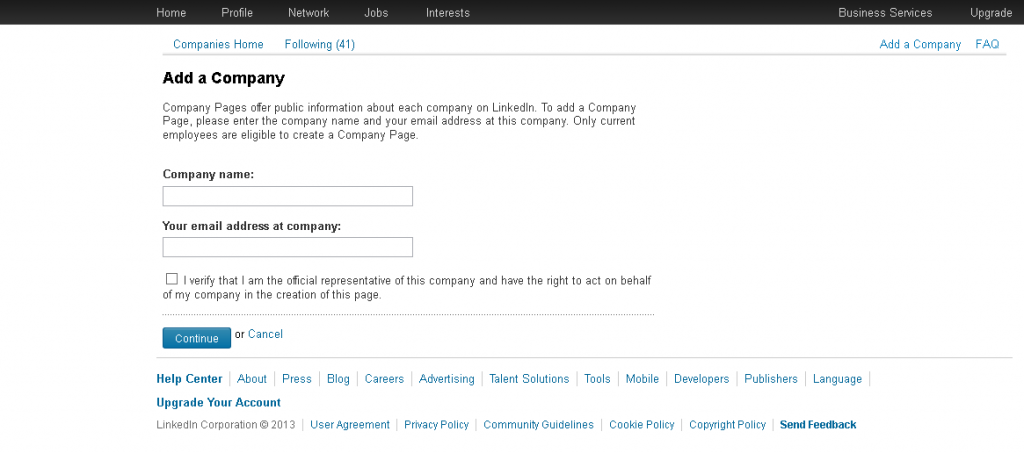While it looks much more corporate and much less fun than Facebook , Instagram and Twitter, there’s no doubt that LinkedIn is hugely valuable for business marketing.
Where other sites take a bit more of a scattergun approach to sharing, LinkedIn allows you to develop a strong network of like-minded, passionate people who are interested in the same things you are – in other words, a hugely receptive network of customers. You can’t pretend you’re not interested in that, can you?
Good company page
Your LinkedIn marketing should be anchored by your company page, where you can tell people what you do and enter status updates promoting your services – including SlideShare presentations and videos.
So far, so Facebook, yes – but that doesn’t mean you can scrimp on your company page. It is, after all, supposed to reflect to the world who you are what you do.
Think of it as a shop window – you wouldn’t leave your high street store display half-empty and uninspiring, so don’t do the same with your company page. It’s where LinkedIn folk will get their first impressions of you, so make sure they’re good ones.
Adding a company
Make sure your profile is keyword-rich to help you in the search rankings – Wordtracker can help you find the most important keywords for you.
Also, ensure your company page links to your website, and if you have any employees with LinkedIn profiles, make sure they’re linked to your page and each other. Doing that extends your network and increases your reach outside your company. It’s a great way to start out with LinkedIn.
Oh, and off to the right is perhaps the most crucial bit of all – the products section. This is where you can list all your services, goods and so on, and other LinkedIn users can add recommendations. If you’ve got great products (of course you do) you can really show them off here. And when you get a recommendation, do take the time to thank the recommendee (yes, I’ve just invented a word there). It helps people view your company in a positive light.
Part of the community
Making a success of LinkedIn marketing is dependent on using its community features effectively. Browse through LinkedIn Groups relevant to your organisation – you’ll find plenty, no matter what your interest. For instance, a quick search for groups about insurance matters in the UK reveals 225 results.
Find some groups that are busy (there are lots of dead ones) and join in some discussions. Don’t immediately dive in and start promoting your products – it’s not good practice. Just post a few thoughts about the group subject, chat a bit, and start to add (‘connect with’ in LinkedIn lingo) other members of your group as contacts.
They’ll add you back and – hopefully – start following your company page too. You could even set up your own group, if you think you’ve got the content – and the time – to devote to it.
It’s a bit of a slow-burn process, but you’ll be able to build up that network of the like-minded passionate people mentioned earlier.
Keeping content
Once you’ve got that network, you can really start posting some brilliant content on your company page status updates. But don’t just copy and paste whatever it is you put on Facebook – as you’ve hopefully established by now, LinkedIn is about deeper engagement than that.
So be thoughtful with what you post. Asking questions is a good way to spark discussion – and LinkedIn is full of chatty types. Going back to the insurance example you could, for instance, comment on something about the news that two-thirds of UK drivers break traffic laws and ask what, if anything, insurers in the UK can (or should) be doing to reduce this high number.
Or you could simply say ‘We’re planning an event on home insurance for later in the year – what sort of content would people like to see?’ Anything that generates a discussion and helps you make contacts and leads.
But you don’t need to – and shouldn’t – share all your content with everyone on LinkedIn all the time. You can target your posts by industry, job title, geography and lots more. A post correctly targeted at the right people will have far more impact than one that’s seen by a lot of people it has little relevance to.
There’s no reason why you can’t subtly mention your products or services as part of the debate in the comments section, but don’t go overboard – LinkedIn is a forum for ideas and debate, predominantly. Remember that, and you won’t go far wrong.
Final thoughts
That’s the basics of LinkedIn marketing, but here are some final other points worth remembering.
Brand your LinkedIn address – when you first join LI, your URL will consist of a load of random characters. Brand it in your own identity as you would on Facebook and Twitter.
Autoblog – Set LinkedIn up so that when you blog, the opening paragraphs automatically appear on your profile with a link back to your site.
Keep connecting – whenever you meet someone in your field at an event, connect with them on LinkedIn too. It helps your online influence grow.
Be analytical – LinkedIn tells you how many people have clicked on your posts and how often they’re shared. Also keep track of your followers and click-throughs to your website. You need to know what content is working for you and what isn’t. After all, content is what keeps your new network engaged – and that’s what’s most important.


